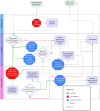Exploring opportunities to enhance the quality of pharmacy-based contraceptive service delivery for adolescents and young women in Kenya: a multimethod qualitative study
- PMID: 40462034
- PMCID: PMC12131450
- DOI: 10.1186/s12913-025-12933-0
Exploring opportunities to enhance the quality of pharmacy-based contraceptive service delivery for adolescents and young women in Kenya: a multimethod qualitative study
Abstract
Introduction: Private-sector pharmacies are a preferred source of contraception in many low- and middle-income country settings, especially among adolescent girls and young women (AGYW), but the quality of contraceptive care and counseling in community pharmacies remains understudied. This study aims to identify and describe barriers, facilitators, and opportunities to improving the quality of pharmacy-based contraceptive care for AGYW.
Methods: In this multi-method, cross-sectional study, conducted from March to June 2023, we triangulated data from semi-structured qualitative interviews with pharmacy providers, flow mapping, and AGYW mystery clients at 20 community pharmacies in Kisumu County, Kenya. Interview transcripts were iteratively coded and analyzed thematically by an interdisciplinary team. Flow maps were visually summarized, and mystery client evaluations were analyzed in a thematic matrix.
Results: Pharmacy providers identified time, concurrent clients, space, lack of adequate provider training, lack of client health education, and stigma related to AGYW sexuality and contraceptive use as key barriers to quality pharmacy-based contraceptive counseling; facilitators included existing rapport with AGYW, provider motivation to serve marginalized AGYW, and respect for client privacy. Providers expressed high demand for training and job aids, and concerns about ineffective or overuse of emergency contraception among AGYW. Flow mapping and mystery client evaluations revealed a variety of quality gaps, including privacy and time bottlenecks, and lack of adequate sharing of contraceptive information.
Conclusions: Our data suggest multiple avenues to improve contraceptive care quality through efforts to enhance privacy and counseling, with the potential for improved reach, person-centeredness, and ultimately reproductive health outcomes for youth. Future research is needed to find the balance between improving quality and maintaining the qualities that make pharmacies preferable to youth in various contexts.
Supplementary Information: The online version contains supplementary material available at 10.1186/s12913-025-12933-0.
Keywords: Adolescent girls and young women; Contraception services; Family planning; Kenya; Pharmacist.
Conflict of interest statement
Declarations. Ethics approval and consent to participate: KEMRI Scientific Ethics Research Unit (KEMRI/SERU/CMR/XXX/4660) and the University of Washington Human Subjects Division (00017655) granted ethical approval for this study, which adhered to the ethical principles of the Declaration of Helsinki. This study was also approved by the Kenya National Commission for Science, Technology, and Innovation (NACOSTI, research permit P/23/24733). Written informed consent was obtained from all interview participants. The authors declare no competing interests. Consent for publication: Not applicable. Competing interests: The authors declare no competing interests.
Figures
References
-
- Gonsalves L, Hindin MJ. Pharmacy provision of sexual and reproductive health commodities to young people: a systematic literature review and synthesis of the evidence. Contraception. 2017;95(4):339–63. 10.1016/J.CONTRACEPTION.2016.12.002. - PubMed
-
- Radovich E, Dennis ML, Wong KLM, et al. Who Meets the contraceptive needs of young women in Sub-Saharan Africa? J Adolesc Health. 2018;62(3):273–80. 10.1016/J.JADOHEALTH.2017.09.013. - PubMed
Grants and funding
LinkOut - more resources
Full Text Sources



